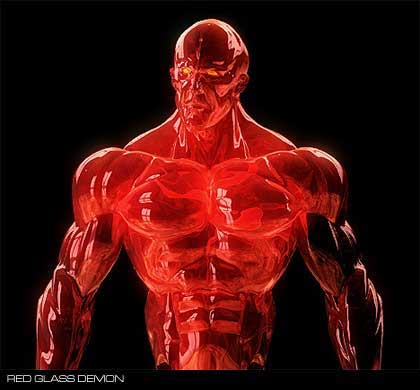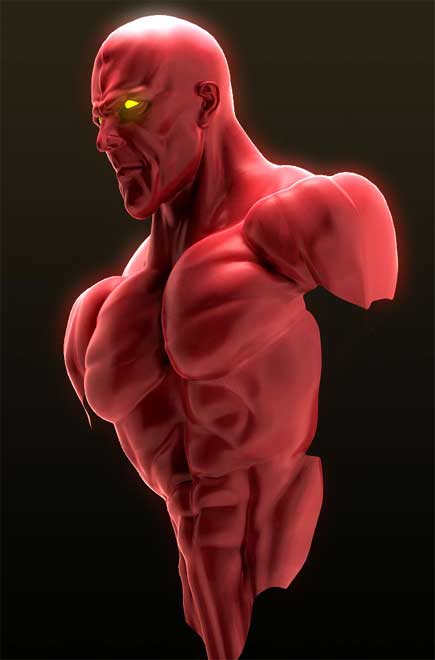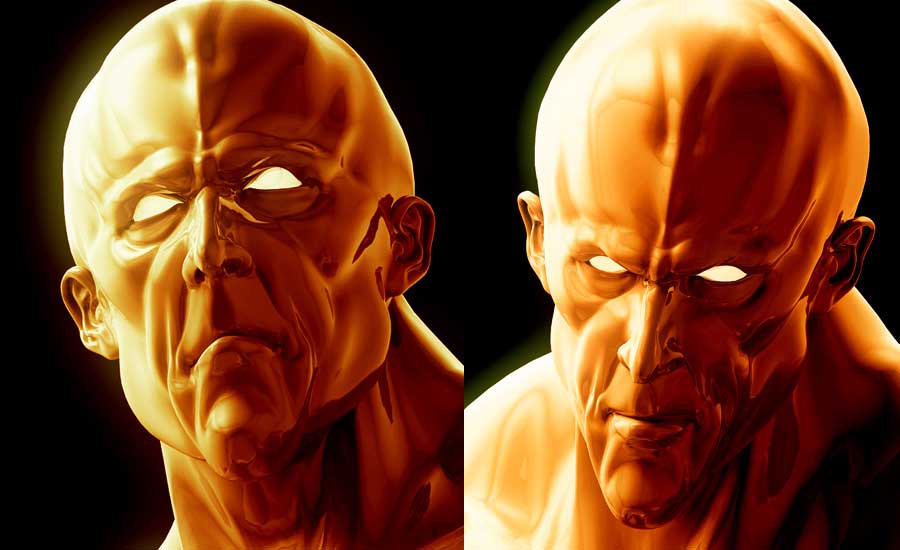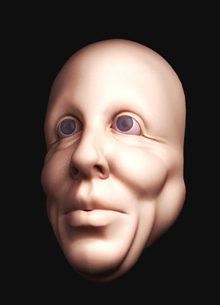Interview with Amaan Akram
CGC: You obviously have great understanding of the human anatomy. Where did you get your training?
AA: I didn’t get any formal training or anything like that. I just dig in to reference material really. I scour the internet and look for anatomical references in as many different lighting situations as possible. I make sure that the form of what I have to model is very clear in my head. And the perception of form is greatly dependant on how it is lit. Not having any tangible references has its disadvantages, but when you have enough pictures of human anatomy in different lighting conditions, a lot of things are cleared up in my mind. Once I know what I have to model, I launch Lightwave Modeler.
My understanding of anatomy is still fairly basic though. In some areas it is good, and in others I am still improving my knowledge.
CGC: How long does it take you to model a typical character?
 AA: That really depends on the type of character that I have to model. To give you an estimate I modeled this face (right) in about 4 hours. I got the initial shape down in about 3 hours, and then tweaked around till I got what I was looking for.
AA: That really depends on the type of character that I have to model. To give you an estimate I modeled this face (right) in about 4 hours. I got the initial shape down in about 3 hours, and then tweaked around till I got what I was looking for.
Another example I’d give here is that of the Demon that I modeled in September. I already had a realistic human face done and added some extra detail to it and exaggerated certain features here and there. The upper torso and the arms and the hands I modeled in about 3 weeks, working about 2 and sometimes 3 hours a day. In between I modeled his back from scratch about 4 times (experimented with different looks). If I worked 8 hours a day every day, I guess I could model something like this demon in about 7 to 8 days.
CGC: Where or how do you usually begin a character modeling project?
AA: Everything starts from an idea. Once I know the initial direction that I have to take, I start looking at reference material. I look at photographs and drawings/paintings (especially of fantasy artists) for inspiration. There are also times when I see someone walking down a street and I get inspired 🙂
The next phase is to plan out the wireframe in my mind (for sub-division surfaces). Sometimes I even draw the wireframe on paper just to clear up a few issues. But mostly I visualize the wireframe on the character that I have to model, and then launch Lightwave Modeler. From there, I proceed poly-by-poly, or using the so-called Box Method to get what I want.
CGC: Could you tell us how you manage the level of details you are able to achieve with your models?
AA: For detailed models, I make sure that I trace out the contours of the model’s surface (muscles and bones) with points and polygons. I look at a detailed surface and see which key areas define its shape, and make sure I get the same areas in to the wireframe. For example, areas where two muscles go over each other affect the look of the skin flowing over them. I trace this intersection with polygons and points, and then put some extra points and polys around this traced shape to provide the bulging effect of muscles on the skin surrounding them.
I also make sure that the modeled surface has a certain degree of visible tension, and the underlying structure is very evident from the flow of the wireframe and from the way it looks in the OpenGL preview. I often see characters with a lot of detail in the surface, but lacking the necessary tension that you see in the works of traditional sculptors.
CGC: What is it you still find difficult about modeling a character?
AA: My modeling technique is now very refined and the whole process of editing point by point seems very straightforward now. However, I get stuck when the look that I have to achieve is not very clear in my mind. Then I hit the reference material again until I know exactly what I am doing wrong. There are also times when I am working on a really complex area and I get this feeling in my stomach like…how on earth am I going to nail this thing. But over the years I have learned that perseverance and patience always get you what you want. I just hold on to this knowledge and keep going. Eventually, I get what I want.
Editor’s note: I wouldn’t want to walk across this guy:
CGC: You work a lot with LightWave, but you also seem to master other major 3D applications. Why do you use LightWave?
AA: I do have some experience with Maya and messiah:Studio. But Lightwave is what I use the most. I have done character rigging with expressions and MEL in Maya. I must say that I love the flexibility it offers. messiah:Studio is a package that I intend to use for my personal character animation projects, but I have yet to really explore it. I am slowly venturing into character animation, and so far have gotten some very decent results. At this stage I spend most of my time thinking about different approaches and doing theoretical stuff to come up with my own style of rigging and animation.
Why do I use Lightwave? I find its modeling tools incredibly powerful and very friendly to use. The renderer is really excellent as well and it lets me transform my ideas in to rendered images very easily. I love the amount of control it gives me in the entire modeling/texturing/rendering process. And I am emotionally attached to the application as well 🙂 I have followed up on Lightwave from the days it was known as VideoScape 3D (about 12..may be 13 years ago). I was 13 or 14 years old at the time and was fascinated by the possibilities it presented. I guess you could say that I grew up with Lightwave. Even though I didn’t get to use it until 1996, but that didn’t stop me from dreaming about it.
CGC: How did you create the inner fractal reflections within your character you call Glass Demon
AA: That’s a common question these days. And the answer is really simple. There are no fractal reflections! People have been asking me what kind of “shader networks” I used to generate the look. For any reflective or transparent object, the environment is the key to getting the right look. That’s what I did. I set up an environment around the Glass Demon for it to reflect and refract. I also used typical glass surface settings (fresnel reflection, refraction and transparency), but added some diffuse and translucency to give the surface a glowing-from-inside look. I added a light in the chest of the Glass Demon, and one outside the surface to get that diffusion and translucency to work the way I wanted it to. And yeah, the polygons for the glass surface are double-sided. This helped in enhancing the illusion of depth.
CGC: Your resum? also shows some programming skills, you write your own shaders?
AA: I graduated from university with a Bachelor of Science degree in Computer Science. However, I haven’t put my programming skills to doing shaders or plugins as of yet. But it’s definitely planned! I used some programming skills of mine to set up some complex expressions in Maya, and it was loads of fun getting to combine art and science in this manner.
CGC: Lighting also plays a very important role in your work. What is the single most important aspect of your lighting?
AA: Story. I set up my lights to tell a story about the subject being lit. Lighting gives me the opportunity to give a lifeless character a sense of past, present, and future, of depth, emotion, and of existence. That is what I strive for when creating my artwork–a story is critical, detail is complimentary.
CGC: Once again, do you have any formal training or do you solely work based on your experience and experimentation?
AA: No training actually. I am an art college reject and that rejection kind of quashed all my hopes of getting formal training. I spend a lot of time thinking though (may be that’s why I am starting to lose my hair) about what I need to do next and what I am not doing right. Time spent away from the computer is as equally important as the time spent at it.
I do experiment a lot with Lightwave, Maya and messiah:Studio. Helps me to forge ahead with my work.
CGC: Will you be taking part of the LightWave/Luxology training tour. If so, what will you be presenting there?
AA: I have very little to do with the Luxology training tour in fact. The tour has been organized by Ford Entertainment group, and I just did a couple of promotional renderings for them. The people (Paul Ford, Matt and many others) who set it up have done a great job from what I have seen so far. Unfortunately, they are not providing training in my part of the world, and so I will be unable to attend.
CGC: What do you think of Luxology?
AA: Actually I am not in a position to comment on Luxology. The team there is great for sure. Everyone in the lightwave world knows the people at Luxology by their names. But I don’t know what or how Luxology intends to work for the future of Lightwave. I am sure whatever they will do, it will be for the advancement of the tool.
CGC: Who are your favorite 3D artists at this moment (inspiration)?
AA: Every day I discover a new inspirational artist! But If I were to mention names of 3D artists, I’d name only--Jeremy Engleman. He is the single most inspirational artist whose work I have come across. After I discovered his work in 1998 and his masterful use of lighting, I could barely sleep for more than 4 hours! All the time I would just look at his work in awe, study his lighting skills, and then evaluate what I was doing wrong. To date no other 3D artist has moved me in such a manner. To date, no other 3D artist has given such an intense inferiority complex 🙂
I would also mention that I am an avid follower of the works of photographers. They are the masters of capturing light. And I also study the work of traditional chiaroscuro artists. They are the masters of inventing light.
I’d like to end this by thanking Jean-Eric and CG Channel. Your dedication to the CG community is very highly admired.
Jean-Eric: Many thanks for Amaan Akram for taking the time to answer our many questions.
Related Links:
Amaan Akram home-page
Luxology’s home-page
LightWave 3D home-page
Ford Entertainment Group (LightWave/Luxology Tour)








